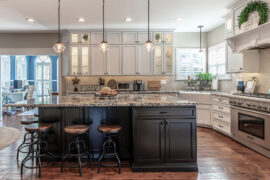The phrase, “The American Dream,” first appeared in a 1931 novel by historian and author James Truslow Adams. In The Epic of America, he spoke of “a land in which life should be better and richer and fuller for everyone, with opportunity for each according to ability or achievement.” This idea that anyone in our country has the chance to work their way towards achieving their own goals and reap the benefits of their own successes is part of every American’s consciousness. It’s what heroes fight for, great leaders protect, scholars debate, and every one of us should celebrate.
World War II summoned America to the world stage to preserve that American Dream. Over sixteen million soldiers left home to serve in action while women took their places in the workforce. Children helped by collecting scrap metal and saving their pennies to buy War Stamps. Every American was expected to support the war effort in some way. American factories churned out more weapons than all other countries combined. When the war was over, soldiers returned to a unified nation with a robust economy. Veterans were rewarded with benefits for education and low interest mortgage rates, and the definition of the American Dream suddenly included home ownership.
Prior to WWII, 40 percent of Americans owned a home. Post WWII, that number had jumped to over 60 percent, where it remains today. As education became more important in the workplace and job requirements diversified, salary levels responded, and the size of the average American home grew right along with rising salaries. In 1940, the average home was 600-800 square feet. By 1960, it had grown to over 1,000 square feet, and today it is still larger at over 2,000 square feet.
As homes got larger, convenience and efficiency became more important, driving innovation and technology. Electric appliances saved time and plastic made maintenance of household goods easier. Women continued to seek work outside of the home and it showed as kitchens evolved into sleeker, smaller spaces. Gone were the days when women had to prepare and serve large meals three times a day in their kitchens. Gone too were rooms created just for show with furnishings everyone admired but no one was allowed to touch or enjoy. New television sets dominated a “family room.”
Technology has continued to dramatically advance and the luxuries of the 1950s, such as vacuum cleaners and televisions sets, are now taken for granted. Having only one television set for the whole household seems unimaginable today. It’s more likely homes have a television set for every room. Vacuum cleaners that replaced the broom and dustpan will now sweep the floors while you are not even home. Smart plugs will turn lights and appliances on and off with just a voice command, and a refrigerator can even let you peek inside while you are at the grocery store!
But not all advancements feel so frivolous. The American Dream home has had an impact on our natural environment and our health. However, scientific progress continues to offer better solutions. Solar and battery technology, lighting innovations, and improved building components are helping us achieve some balance between the built environment and the natural environment.
While environmental, economic, and cultural influences have impacted what we consider an American dream home, the desire to have a place of our own has never changed. Our home has always been a statement about who we are and what we want people to think of us. Trends may cycle through the decades, making the old new again, as if we will do it better each time we revisit tradition. Back to the kitchen for instance. They have expanded again! Smaller, compact kitchens are fading away, not because we’ve gone back to cooking more, but because that’s where we live these days. This time around, it’s where we entertain our friends, where we work, and where we have meaningful interaction with our children.
We are more focused on comfort too, needing our homes to be our refuge from a hectic, sometimes uncivilized society. We want a place where we connect with our family, recharge our resolve to live our best lives, and encourage one another to dream big.
When Thomas Jefferson penned the Declaration of Independence, he set the American Dream in motion. “We hold these truths to be self-evident, that all men are created equal, that they are endowed by their Creator with certain unalienable Rights, that among these are Life, Liberty and the pursuit of Happiness.” We are free to pursue our own destinies. We are free to live in our own version of the American dream home, where we spend time with those we love, instilling in the next generation the values of freedom each of us so rightly cherishes.





